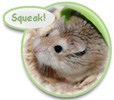Dwarf Campbells Hamster
From Hamster Central WIKI
The Dwarf Campbell’s Russian hamster ”Phodophus campbelli” was named after W.C Campbell who discovered the rodent in Mongolia in 1902. It is found in central Asia, northern Russia, Mongolia and northern china.
They hamster arrived in Britain in 1964 as lab animals. From there they progressed into pets store in the early 1970’s and shortly after to the United States.
The Campbell’s Hamster is sometimes incorrectly labeled as the Siberian Hamster in pet shops. It is more common than the other species of Dwarf Russian Hamsters. The name Djungarian “jung-gair-rian” is another used for the Campbell’s and the Winter White Hamster because at one time it was believed they thought to be subspecies of the same animal.
They approximately 3¼ -4¾ inches (10-12cm) in length when full grown, males being larger than females. They are sociable and will live with others of it’s own kind in single or mixed sex groups provided that hamsters are introduced at a young age. Because of their small size they are harder to hold and may not be suitable for children because of this reason. They can also be less tolerant of clumsy handling than the bigger Syrian Hamster and more prone to nipping.
Campbell’s Hamsters establish an order of hierarchy so one hamster will be dominant over another. This establishment and reinforcement of dominance is often seen in "squabbling" although there is usually little physical contact.
Cages designed for mice, glass or plastic aquariums make more suitable cages since they are capable of squeezing through the bars of some hamster cages.
A well-balanced dry hamster mix will contain all the necessary nutritional requirements that the hamster needs. They do enjoy the occasional treat in the form of fruit and vegetables and of course always require fresh water.
The 'original' color of the Dwarf Campbell’s Russian Hamster in the wild is brownish-gray with an ivory belly and has a darker line down the center of the back. But selective breeding now has the Campbell’s offered in some 40 color and coat combinations. Their coat comes in two types and textures. These are satin, which makes the hamster look wet and greasy, and wavy. The wavy coat is only noticeable in young hamsters.
One unique thing about the Campbell’s is that the male plays a substantial role in the raising and survival of the pups. The male will participate in the birth and rearing of the young and assists during the birthing process licking and sniffing them opening up their airways once delivered. They will continue providing direct care, hopping into the nest while the mother is absent.
Life expectancy is a year to a year and a half, but some have lived up to four years.



